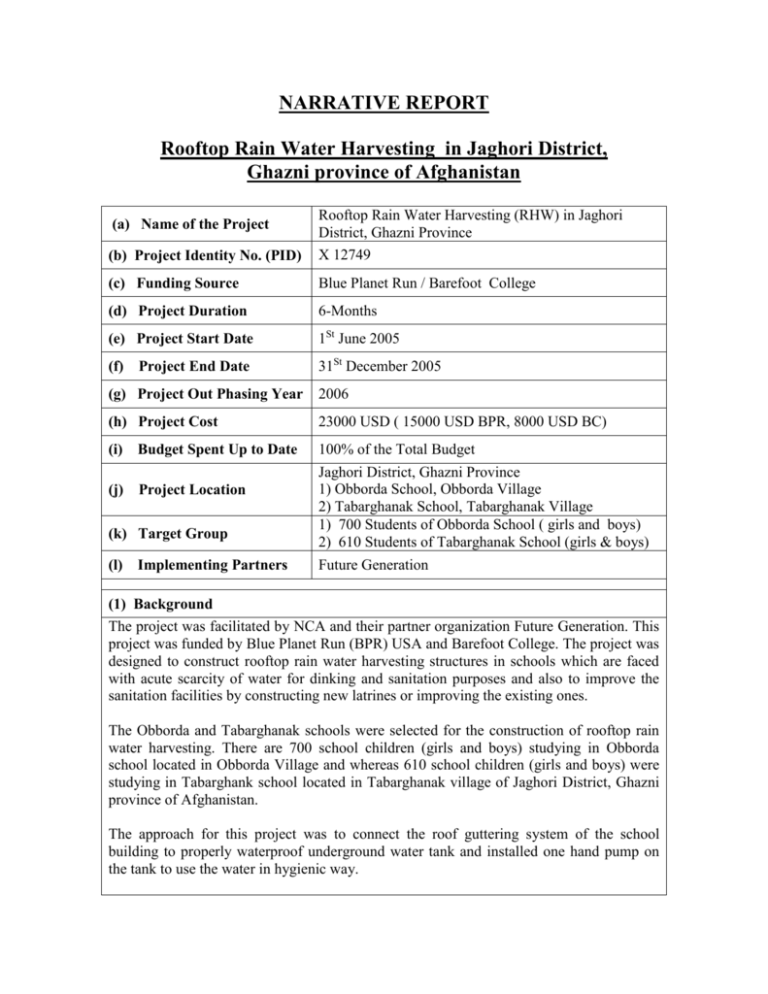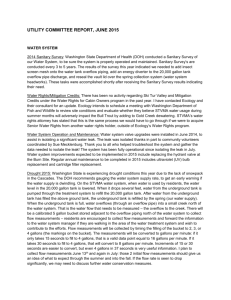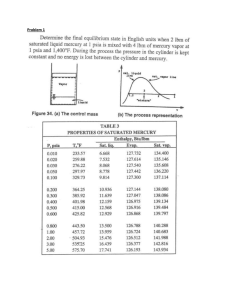NARRATIVE REPORT
advertisement

NARRATIVE REPORT Rooftop Rain Water Harvesting in Jaghori District, Ghazni province of Afghanistan (a) Name of the Project Rooftop Rain Water Harvesting (RHW) in Jaghori District, Ghazni Province (b) Project Identity No. (PID) X 12749 (c) Funding Source Blue Planet Run / Barefoot College (d) Project Duration 6-Months (e) Project Start Date 1St June 2005 (f) 31St December 2005 Project End Date (g) Project Out Phasing Year 2006 (h) Project Cost 23000 USD ( 15000 USD BPR, 8000 USD BC) (i) Budget Spent Up to Date 100% of the Total Budget (j) Project Location (k) Target Group (l) Implementing Partners Jaghori District, Ghazni Province 1) Obborda School, Obborda Village 2) Tabarghanak School, Tabarghanak Village 1) 700 Students of Obborda School ( girls and boys) 2) 610 Students of Tabarghanak School (girls & boys) Future Generation (1) Background The project was facilitated by NCA and their partner organization Future Generation. This project was funded by Blue Planet Run (BPR) USA and Barefoot College. The project was designed to construct rooftop rain water harvesting structures in schools which are faced with acute scarcity of water for dinking and sanitation purposes and also to improve the sanitation facilities by constructing new latrines or improving the existing ones. The Obborda and Tabarghanak schools were selected for the construction of rooftop rain water harvesting. There are 700 school children (girls and boys) studying in Obborda school located in Obborda Village and whereas 610 school children (girls and boys) were studying in Tabarghank school located in Tabarghanak village of Jaghori District, Ghazni province of Afghanistan. The approach for this project was to connect the roof guttering system of the school building to properly waterproof underground water tank and installed one hand pump on the tank to use the water in hygienic way. The roof of the Obborda School building is GI Sheet with wooden trusses of 25 degree angel. The PVC guttering pipes are connected with underground water tank for the collection of rain water from the top of the roof. The roof of Tabarghanak school is plat RCC slab and the PVC guttering pipes are connected with storage tank for the collection of rain water from the top of roof. (2) Implementation Process Future Generation made a contract with Pulghoo Construction Co. To carry out the construction activities of these projects. For the quality control staff members of Future Generation were employed full time, and one partial time as a supervisor for 6 months. In the implementation of this project, two barefoot engineers with knowledge in rainwater harvesting were called upon to assist Future Generation. The project was monitored by Future Generation during the implementation period. The project was coordinated with School authorities and local communities. Instead of constructing the traditional pit latrine for sanitation Obborda school authorities asked for the improvement of the exiting latrines by installation of 6commode (WC) with water tank for the flashing purposes. 184 skilled and 512 unskilled worker were employed to carry out the construction activities which includes (Stone masonry work, plumbing work, steel binding, shuttering, concerting and plastering) (3) Main Results: (3a) Outputs and effects in accordance with the project objectives - Qualitative and quantitative effects in relation to target groups: The RRWH structure in Oborda school is 100% completed. The construction activities in Obborda School includes: - Construction of one underground water tank size 5 X 4 X 3.5 cu-m for the collection of rooftop rain water. Construction of retaining walls 56 cu-m Stone masonry with cement sand mortar Installation of 2- hand pump Supply and Installation of 450 gallons capacity water tank for latrines flash system. Installation of 6 commodes (WC) in 6 Cells of latrines for boys and girls. Putting of PVC pipe for collection of water Water proofing the underground water tank - RCC on top of Underground water tank The construction activities in Tabarghanak School includes: - Construction of one underground water tank size 4.6 x 4.7 x 3 cu-m for the collection of rooftop rain water. Construction of retaining walls of Stone masonry with cement sand mortar Installation of 2- hand pump Putting of PVC pipe for collection of water from the rooftop and directing to the underground water tank Water proofing the underground water tank RCC on top of Underground water tank The effect of the project is not yet measured or assessed due to lack of rainfall. The effect will be measured at the end of March 2006 and followed by yearly monitoring assessment. This will be documented in the next monitoring report and will be submitted to both Blue Planet and Barefoot College. The benefits of project are: - It is anticipated that the two schools will benefit from the provision of clean water for drinking and personal hygiene facilities. - These two projects helped in the creation of employment opportunities for 184 skilled rural youth and 512 unskilled workers. (3b) Community Contribution: Specify what, who, how, how much (% in relation to the total budget): In all projects, the NCA approach is that the community has to make a contribution towards the project, as well as taking part in decisions concerning the implementation. The community & local authorities contribution includes: - Excavation for the underground water tank. - Excavation for the septic tank - Provision of storage facilities for the construction materials - Providing the security to workers and project staffs. (3c) Direct and Indirect Beneficiaries (% of the target group benefiting from the project within each community): It is expected that 1310 (boys and girls) and staffs from the two school will be the direct beneficiaries, unfortunately this figure could not be ascertained due to lack of rainfall in the target areas. However, the exact numbers of direct beneficiaries could only be determined after the rainy season and when the tank has water. During the construction 184-skilled rural youth and 512 unskilled workers indirectly benefited from project through employment. (4) Progress and Main Deviations compared to plans and budgets: Progress - The project started according to the plan on 1st June 2005, and completed 100% at the end of December 2005 within the project timeframe. Deviation in accordance to the plan in Obborda School - The installation of 6 commodes (WC) in the existing latrines instead of construction 2 traditional pit latrine. - installation of water tanks with a capacity for 450 gallons for the flashing purposes of 6 new installed commodes (WC) - Construction of one septic tank for the 6 latrines. (5) Special Challenges and Concerns: - It is necessary that first flash of rain should not be allowed into storage tank it should be used for the cleaning of guttering pipes and roofs area. - Chlorination of the water should be done. - The main challenge is that acceptances of rain water collection for drinking and hygiene purposes are not a common practice in Afghanistan. (6) Sustainability: The sustainability will depend on a proper operation and maintenance of the RWH Structures. Close follow up and monitoring is needed for the proper use of stored water for drinking and personal hygiene. (7) Recommendations: It is recommended that the Obborda and Tabarghanak schools authorities: - Should develop a proper water management routine for the use of water. - Water in the storage tank should be chlorine treated. - The surface water run off from school compound during the rainy season should not be allowed to flow inside the underground water tank other wise it will pollute the water. - Creation of a RWH committee for the operation and maintenance on village level (8) Monitoring 1. Monitoring should be done twice in a year: 2. Monitoring Date: End of March 2006 By: Jamal, & Nabi Final Monitoring report will be send to you at the end of march 2006 with picture







